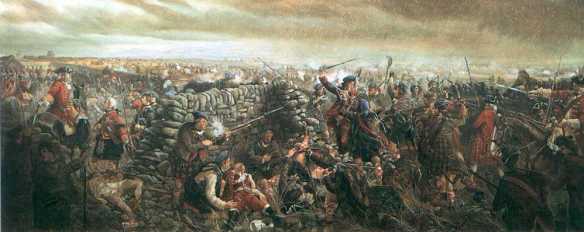
The Battle of Culloden by Mark Churms. The panoramic view of the last battle fought on British soil, at the moment where MacBean stands in the breach in the wall.
For over 1,000 years, Celtic Highland society was founded on a clan system, built on family ties to create loyal groups dependent on a feudal chief. However, the clans were systematically broken up by England after 1746, following the defeat of the Jacobite attempt on the British crown, led by Bonnie Prince Charlie (see p153). A more romantic vision of the Highlands began to emerge in the early 19th century. Its creation was largely due to Sir er Scott, whose novels and Waltery depicted the majesty and poetrgrandeur of a country previously considered merely poverty-stricken and barbaric. Another great popularizer was Queen Victoria, whose passion for Balmoral Castle helped to establish the trend for acquiring Highland sporting estates. But behind the sentimentality lay harsh economic realities that drove generations of Highland farmers to seek a new life overseas.
Today, over half the inhabitants of the Highlands and islands still live in communities of less than 1,000 people. But thriving oil and tourist industries have supplemented fishing and whisky, and population figures are rising.
UNION WITH ENGLAND
Mary’s son, James VI, had reigned for 36 years when he became heir to the English throne. In 1603 he moved his court to London (taking his golf clubs), thus removing the monarchy from a permanent presence in Scotland for good. Scotland still retained its own parliament but found it increasingly difficult to trade in the face of restrictive English laws. In 1698 it tried to break the English monopoly on foreign trade by starting its own colony in Panama, a scheme that failed and brought financial ruin.
The first proposal to unite the two parliaments received a hostile reception from the public. Yet influential Scots saw union as a means of securing equal trading rights. The English saw it as a means of securing the Protestant line of succession to the throne, for by now the deposed Stuarts were threatening to reinstate the Catholic line. James VII was deposed in 1689 and fled to France. In 1707 the Act of Union was passed and the Scottish Parliament was dissolved.
THE MASSACRE OF GLENCOE
In 1692, the chief of the Glencoe MacDonalds was five days late in registering an oath of submission to William III, giving the government an excuse to root out a nest of Jacobite supporters. For ten days 130 soldiers, captained by Robert Campbell, were hospitably entertained by the unsuspecting MacDonalds. At dawn on 13 February, in a terrible breach of trust, the soldiers fell on their hosts, killing some 38 MacDonalds. Many more died in their wintry mountain hideouts. The massacre, unsurprisingly, became a political scandal, though there were to be no official reprimands for three years.
BONNIE PRINCE CHARLIE AND THE JACOBITES
In 1745 James VII’s grandson, Prince Charles Edward Stuart, secretly entered Scotland, landing on the west Highland coast with seven men and a promise of French military support, which never materialized. His call to arms to overthrow the Hanoverian usurper, George II, drew a poor response and only a few Highland chiefs offered support. From this dismal start his campaign achieved remarkable success, but indecisive leadership weakened the side.
The rebel army came within 200 km (125 miles) of London, throwing the city into panic, before losing heart and retreating. At Culloden, near Inverness, the Hanoverian army (which included many Scots, for this was not an issue of nationalism) defeated the Jacobites on a snowy 16 April 1746. The cause was lost. Bonnie Prince Charlie became a fugitive hotly pursued for six months, but despite a £30,000 reward on his head he was never betrayed.
THE AFTERMATH OF CULLODEN AND THE CLEARANCES
Culloden was the turning point in Highland history, such was the severity of the oppressive measures following the battle. An Act was passed banning the wearing of tartan, the playing of pipes and the carrying of arms. The ties of kinship between chief and people were severed, and a way of life was extinguished. From then on chiefs assumed the roles of feudal landlords, and the land, once held for the people, became their private property. When sheep were found to thrive profitably on the land, the people became a hindrance and, as a result, were removed.
The evictions, or socalled Clearances [Ethnic Cleansing], began in the 1760s. Some were achieved quite peacefully through financial incentives, but increasingly they were enforced through violence and burning, the most notorious taking place on the Duke of Sutherland’s estate in 1814. In the 1860s, by which time Queen Victoria had made the Highlands popular and sporting estates all the rage for hunting deer, the inland glens were as empty as they are today.